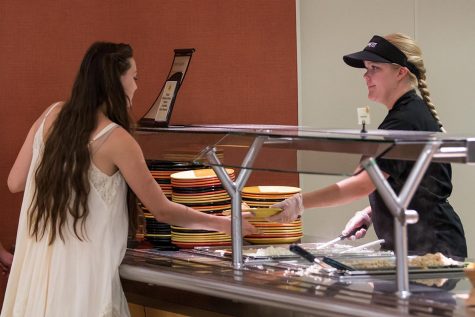Economics and culture contribute to obesity
The solutions to childhood obesity lie in more than just exercise.
John Uy/THE CHIMES
November 11, 2015
It reflects poorly on American culture that about 12.7 million children and adolescents between the ages of two and 19 are obese.
Various Reasons
Various reasons are cited for this health problem from eating too much junk food to not exercising anything but fingers through activities like texting and video games. The Center for Disease Control recommends children get about an hour of physical activity each day. If kids are not involved in some kind of sport, then it becomes difficult to exercise for 60 minutes every day — at least it becomes harder than when I was a kid.
When I was growing up back in the sixties and seventies, more moms stayed at home and we played outside with the neighborhood kids after school. We rode bikes, skateboarded or climbed trees. It was easy for me to get in an hour of activity per day.
The Main Culprit
In contrast, today more homes are dual income and kids are carted off to day-care centers after school. I see more neighborhoods appear mostly empty of children playing outside. It is not just because they are involved in after school activities, either. It is a safety issue. Many parents simply do not trust allowing their children the freedom to roam the neighborhoods for fear of predators.
However, lack of exercise is not the main culprit in why kids are overweight — what they eat is the main contributor to obesity. Poor children are among some of the more overweight. Their parents do not have enough money to buy the more expensive, healthier foods. Interestingly enough, lack of breastfeeding also contributes to childhood obesity, according to the CDC.
Most moms try breastfeeding at first, but with little to no follow up medical support, they quit when it get tough. The CDC states only 13 percent are exclusively breastfeeding their babies at the end of 6 months. Advertisers do not help either, aiming their sugary food products directly at kids.
Excessively Large Amounts
Although McDonald’s no longer sells “Super Size” fries and drinks, they and other fast food restaurants still sell excessively large amounts of food. Just one bacon clubhouse crispy chicken sandwich has 750 calories and nearly three quarters of the daily recommended amount of sodium. Wendy’s offers Dave’s Hot ‘N Juicy three-quarter pound triple with cheese that has 1,100 calories and 150 percent of the daily recommended intake of saturated fat. Sit-down restaurants surely do not skimp on the portion sizes, either.
As a parent of two kids myself, neither of them are overweight because our family earns enough to buy healthier food options. I home-cook most of our meals and I breast fed both of my children up until they were one-years-old. I was fortunate in that I have a husband who supports our family moderately enough to be able to live this healthier lifestyle. Single moms do not have that benefit. Parenting was never meant to be solo.
Lifestyle Choices
From a Christian perspective, self-control has to play into this issue as well. We are allowed to eat anything we want, but not everything is beneficial as it says in 1 Corinthians 10:23. If we cannot afford the more expensive healthy food options, growing our own fruits, nuts and vegetables presents a possible alternative if the space is available. Growing a small, organic vegetable garden would also provide children some more physical activity in tending to it.
As exhorted to us in 2 Corinthians 10:3, we should be counter-cultural in our lifestyle choices. Although we live in the world, we should not live as the world does and through understanding of the causes of childhood obesity, we can make wise choices for ourselves, understand the situations of others and work towards ending this disease.







